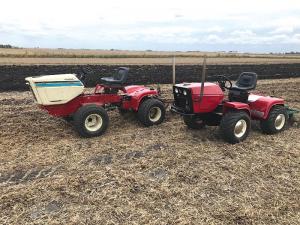2021 - Volume #45, Issue #4, Page #08
[ Sample Stories From This Issue | List of All Stories In This Issue | Print this story
| Read this issue]
Tractor Therapy Became His Business
 |
“I was just getting over chemotherapy and figured no one would hire me with a diagnosis of stage 4 liver cancer,” says Bruggeman. “My three sons, Nick, Alex and Eric, asked me what I was going to do. I had seen a self-propelled, articulated quad tractor made from a Cub Cadet. I told them I thought I could build one. At first, they laughed at me.”
A month later, his sons had collected multiple Cubs, delivered them to his driveway, and said, “Have at it.” So Bruggeman did.
“I told them I would build it as cheaply as I could. I figured I wouldn’t get it finished because the cancer would get me first, and it would end up in one of their sheds,” recalls Bruggeman. “I was wrong. It worked out just fine.”
He started by stripping down an 1864 Cub, removing the front and rear axles. After mocking up the frame, he moved the rear axle beneath the steering wheel.
“I didn’t have a plan or even a good idea of what it would look like,” says Bruggeman. “I did drive through some IH dealerships to see what quads with articulation looked like. That gave me an idea.”
He decided to stack the 1864 frame with the engine over a section of a rear frame. Once again, he arranged the lower frame section, so the “new” front axle was underneath the steering wheel. A front hydrostatic transmission was bolted to it and connected to the engine with multiple belts and pulleys. A third tractor’s rear frame with axle was chopped just ahead of its transmission and turned into an articulated rear end.
Bruggeman built the articulation joint out of 1/2-in. steel plate with upper and lower hitch arms. A section of steel plate sits under the rear transmission. A three-sided, vertical steel collar is welded to the transmission floor and bolted to the frame of the rear section.
The lower hitch arm is a 2-in. wide piece of 1/2-in. thick steel that extends from the transmission floor forward. It connects to the tractor’s front frame with a ball hitch from a 3-pt. arm. The upper hitch arm is a top link from a 3-pt. hitch.
“The 3-pt. hitch elements give the tractor both articulation and oscillation,” says Bruggeman. “I attached hydraulic cylinders from power steering systems in the 1864 and another tractor between the two halves to control turning. I connected them to the steering valve.”
A driveshaft from the engine connects to the rear transmission with a universal joint between the two frames. To synchronize the two transmissions, Bruggeman removed the trunnion spring from the rear transmission.
“I bolted an automotive cable to the front trunnion, ran it through the articulation joint, and bolted it to the rear trunnion,” says Bruggeman. “I had the whole tractor up on blocks so I could adjust the cable until all 4 wheels were turning at the same rate backward and forward.”
Bruggeman then ran a second cable from the front transmission to the hydrostat lever on the dash. A third cable runs to the brake pedal.
Hydraulics for the rear 3-pt. hitch come off the rear transmission with hoses running forward to valves on the dash.
Bruggeman figures it takes 5 tractors to make one quad. A 682 supplied the hood and 1 transmission. The 1864 supplied its power steering, frame and the second transmission. The rear fender pan alone took parts of 3 fenders.
“Building that first quad, which is powered by a 25 hp. Kohler, took 8 mos.,” says Bruggeman. “I built a second one with a 19 hp. Kubota diesel in about 4 mos.”
On the second tractor, he opted for a used transfer case from a Yamaha motorcycle instead of belts and pulleys to drive the lead transmission. He plans to replace the belts and pulley system on his first one as well.
Bruggeman says his tractor therapy continues to go well. “It gets me out of the house and going in the morning,” he says. “In January of 2015 I was told I had 2 months to live. I started building my first tractor in 2017 and am still going. I have since built a custom-ordered 3488 with a cab and have orders for 3 or 4 more quads. I have around 40 Cubs ready to use for parts for my tractors and to sell to others.”
Contact: FARM SHOW Followup, Norman H. Bruggeman, 1947 Red Tail Dr., Waterloo, Iowa 50701 (ph 641-425-2534; normanh20@gmail.com).

Click here to download page story appeared in.

Click here to read entire issue
To read the rest of this story, download this issue below or click here to register with your account number.




